The first version of the lock was not very elegant, and the key kept catching on the corners of the brackets, so I revised my plan.
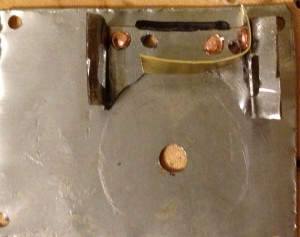 Here you can see the main mechanism of the new lock. Instead of two brackets, there is one bracket with rectangular holes on either end. This makes it easier to clear the path of the key, though it does have other issues that will be seen later. I had originally planned to use the same leaf spring design as the v.1.0 lock, but after going back to look at my source images I decided to try attacking the spring to one of the bracket flanges instead. While the theory was sound, the piece of brass shown here did not have sufficient stiffness to maintain good tension.
Here you can see the main mechanism of the new lock. Instead of two brackets, there is one bracket with rectangular holes on either end. This makes it easier to clear the path of the key, though it does have other issues that will be seen later. I had originally planned to use the same leaf spring design as the v.1.0 lock, but after going back to look at my source images I decided to try attacking the spring to one of the bracket flanges instead. While the theory was sound, the piece of brass shown here did not have sufficient stiffness to maintain good tension.
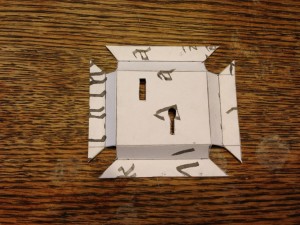 This is the paper template for the lock cover, including placement of the keyhole and the slot where the hasp will connect to the bolt.
This is the paper template for the lock cover, including placement of the keyhole and the slot where the hasp will connect to the bolt.
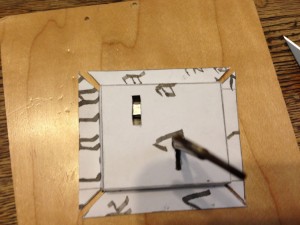 Here is the paper template placed over the lock mechanism. You can see the bolt in the locked position inside the slot.
Here is the paper template placed over the lock mechanism. You can see the bolt in the locked position inside the slot.
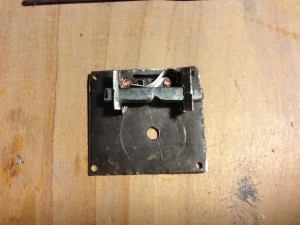
This is v.2.1 of the lock mechanism. The problem with the v.1.0 leaf spring was that the piece of hair barrette I was using was too narrow to properly engage the bolt (and also hard to attach). The solution, therefore, was a wider barrette. A quick trip to the dollar store got me a 6-pack of nice flat barrettes of various widths. The previous orientation of the brass spring didn’t work with the stiffer steel, so I flipped it upside down and bent it to where it needed to be. Bending the spring had to be done very carefully, as it breaks easily if bent too sharply.
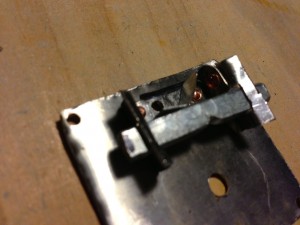
This is a closer shot showing the attachment of the spring. I had a problem later with the bolt, after the cover was in place. While the bolt was prevented from going too far to the right by the side of the lock cover, there was really nothing to prevent it going too far to the left from an over-enthusiastic turn of the key or vibration from hammering. There is no sound quite as depressing as a bolt rattling around loose inside a nailed-on lock. I had to pull out nails (twice) to fix a wayward bolt. In the end I put the bolt in the vise and mushroomed the right end of it slightly so it would no longer be able to fit through the hole in the bracket. Problem solved!
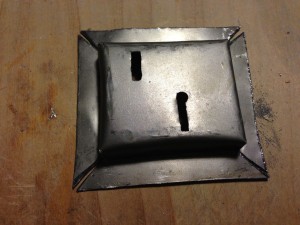 Here is the lock cover cut out of the same steel as the rest of the hardware and bent into shape. It took some finagling to get everything going the right way, but it all turned out in the end.
Here is the lock cover cut out of the same steel as the rest of the hardware and bent into shape. It took some finagling to get everything going the right way, but it all turned out in the end.
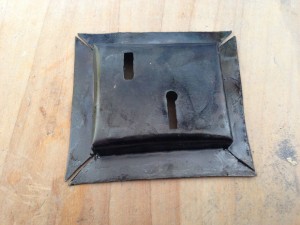 Since I wanted to mount the lock on the front of the box before it was fully assembled, that meant the lock cover was the first piece that needed to be blackened. I placed the cover on a piece of fire brick on top of the anvil and heated it with a propane torch. Once it was hot enough that black oxide appeared on the surface, I picked it up with a specialized tool (coat hanger with one end bent into a hook) and dunked it in a metal bowl of safflower oil. I removed it from the oil, let most of it drip off, then put it back on the fire brick to heat it again. This process was repeated one more time just to be sure. I also had to go back and re-treat the edges later after I dinged it up trying to pull out nails.
Since I wanted to mount the lock on the front of the box before it was fully assembled, that meant the lock cover was the first piece that needed to be blackened. I placed the cover on a piece of fire brick on top of the anvil and heated it with a propane torch. Once it was hot enough that black oxide appeared on the surface, I picked it up with a specialized tool (coat hanger with one end bent into a hook) and dunked it in a metal bowl of safflower oil. I removed it from the oil, let most of it drip off, then put it back on the fire brick to heat it again. This process was repeated one more time just to be sure. I also had to go back and re-treat the edges later after I dinged it up trying to pull out nails.
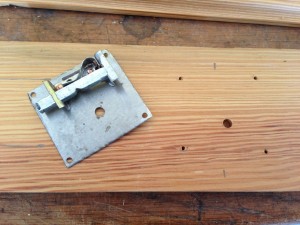
Here you can see the lock mechanism ready to be mounted to the front board of the box. The center point of the board is marked in pencil, but the lock mechanism is offset slightly relative to the cover. You can also see the hole drilled for the post of the key.
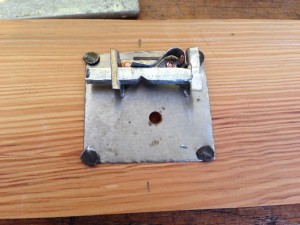 The lock mechanism nailed in place. These are 9/16″ black cut nails that I found at Lowe’s for super cheap. They hold well and look good, so I ended up using them for all the construction of this box (with one exception).
The lock mechanism nailed in place. These are 9/16″ black cut nails that I found at Lowe’s for super cheap. They hold well and look good, so I ended up using them for all the construction of this box (with one exception).
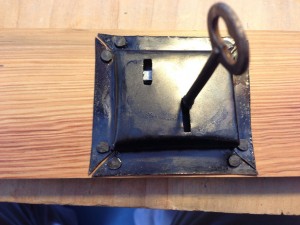 The completed lock installed. I did not, in fact, ever check to make sure the lock cover would fit on the front of the box. I could have cut off the top and/or bottom flanges to make it fit if I needed to, but I got lucky and was able to squeeze it in as is. Once the cover was in place, it turned out that I had to file down the bit of the key just a smidge to make sure it cleared everything inside. Next time, the actual construction of the box!
The completed lock installed. I did not, in fact, ever check to make sure the lock cover would fit on the front of the box. I could have cut off the top and/or bottom flanges to make it fit if I needed to, but I got lucky and was able to squeeze it in as is. Once the cover was in place, it turned out that I had to file down the bit of the key just a smidge to make sure it cleared everything inside. Next time, the actual construction of the box!
